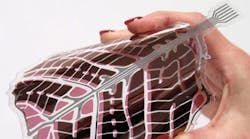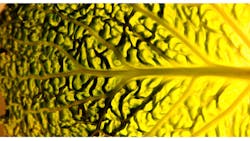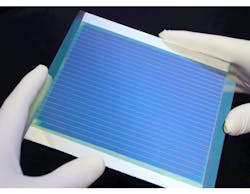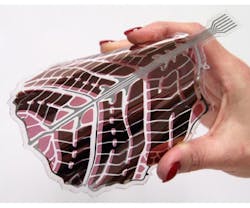Could Cloudy Days And Flower Power Be The New Blue Sky Thinking On Solar Energy?
Organic photovoltaics and power from plants are providing some bright alternatives to the traditional electronics technology used in solar panels. A team of British scientists has developed organically based solar panels that actually work more efficiently on a cloudy day and will better suit weather conditions typically experienced in northern Europe. Tests have shown the panels in direct sunlight manage 10% efficiency, but in cloudy conditions that increased to 13%.
Traditional solar panels are constructed with silicon-based semiconductors. When light falls on them, a percentage of the energy is absorbed and frees electrons that can be made into a current. The cloud-friendly technology employs organic molecules as semiconductors that can be dissolved in a solution and manufactured into a thin flexible material using a 3D printer.
Although the material is still in the developmental research stage, its possible uses are numerous. Because it is lightweight, it could be fitted to roofs easily without additional structural support. It also could be used to make clothes and bags that could recharge mobile devices carried in them. And, carmakers are considering it as a possible roof covering that would help to charge the car’s electrical systems.
Power Plants
The desire to harvest the sun’s energy more efficiently is producing more than just conventional research into how organic semiconductors can help. Scientists have been trying to understand how plant life could greatly contribute to how we exploit solar power. Such research is at a very early stage and is deeply complex.
During photosynthesis, the photons that are captured by plants split water molecules into oxygen and hydrogen. By doing so, they produce electrons (Fig. 1). The electrons then create sugars that are sustenance for the plant. Researchers have developed a way to impede photosynthesis and deflect the electrons before they create plant sugars.
Structures in the plant cell called thylakoids, which are responsible for capturing and storing energy from sunlight, are partitioned. Researchers manipulate the proteins in the thylakoids, interrupting the pathway along which electrons flow.
These modified thylakoids are then immobilised using carbon nanotubes. The nanotubes act as an electrical conductor, capturing the electrons from the plant and transmitting them along a wire.
Why is this flower power research important? Photosynthetic plants operate at close to 100% efficiency, which means that almost every photon of sunlight absorbed by the plant is converted into an electron. This is impressive given that most current solar cells achieve approximately 12% to 17% efficiency.
Fullerene-Free Breakthrough
Increasing the efficiency of solar cells is, therefore, the constant ambition of engineers and scientists. Research centre Imec has developed fullerene-free organic photovoltaic (OPV) multilayer stacks, achieving a record conversion efficiency of 8.4% (Fig. 2)
This progressive step brings OPV cells to a higher level in the highly competitive thin-film photovoltaics marketplace. But although the power conversion efficiency of organic solar cells has increased in the last decade, further design improvements are essential to make the mass production of OPVs viable.
Imec’s organic solar cells were created by the implementation of fullerene-free acceptor materials that provided high open-circuit voltages and useful absorption spectra. Also, high short-circuit currents were achieved by developing a device consisting of three active semiconductor layers with complementary absorption spectra and an efficient harvesting mechanism.
Fullerenes are the preferred acceptor materials in current OPV cells because they accept stable electrons and their high electron mobility. However, the small absorption overlap with the solar spectrum limits the photocurrent generation in fullerene acceptors, and their deep energy level for electron conduction limits the open-circuit voltage. Imec implemented two fullerene-free materials as acceptors, increasing open-circuit voltages compared to OPV cells with fullerene acceptors.
To increase organic solar cell efficiency, complex architectures are often implemented to combine the exciton harvesting of multiple photoactive materials. Accordingly, Imec believes a simple three-layer stack will improve the spectral responsivity range.
The architecture comprises two fullerene-free acceptors and a donor, arranged as discrete heterojunctions. Such a configuration in conjunction with an open-circuit voltage close to 1 V achieves a power conversion efficiency of 8.4%. These results confirm that multilayer cascade structures are a promising alternative to conventional donor-fullerene organic solar cells.
European Project
Imec’s work is an important contribution to the objectives of the European FP7 project ArtESun, which aims to develop highly efficient organic solar cells that are cheap to manufacture and exhibit operational longevity. The ultimate goal of the ArtESun project is to bring OPVs towards introduction into the competitive thin-film photovoltaic market.
Researchers also want to understand the long-term stable operation and the degradation mechanisms at the material and OPV device level. They want to develop roll-to-roll additive non-vacuum coating and printing techniques as well.
Playing its part in this project is VTT Technical Research Centre of Finland, which has produced customised shape and performance OPV leaf modules using printing methods (Fig. 3).
The ArtESun project is partly funded by the European Commission. Within the framework of the ArtESun project, VTT collaborates with Imec (Belgium), Fraunhofer ISE (Germany), Imperial College (U.K.), IKERLAN S.Coop. (Spain), Corning SAS (France), ONYX Solar Energy S.L (Spain), Confidex OY (Finland), Wibicom Inc. (Canada), and SAFC Hitech (UK)



